Be sure to also visit our Memories page, where you'll find personal remembrances and history by folks from the Rison-Dallas village.
(NOTE: Click here to read a very interesting article by Collins Wynn about how the roads and area names in Huntsville have changed over the years)
(NOTE: Click here to read another interesting article from Collins Wynn about a Union Army encampment in the Oakwood Avenue and Maysville Road area around 1875.
History – Just what does it mean when we talk about history? To paraphrase Webster’s Dictionary, history means to record past events – an account of what has or might have happened in the development of people and places; in other words, all recorded events of the past, usually in chronological order.
Because it seemed that we had no alternative way in which to preserve our history of Rison School and Dallas Village, this website was created.
In the process of collecting material for the site, a suggestion was made that a visit to the Heritage Room of the Huntsville-Madison County Library would be a good resource for material. A visit to the Heritage Room was made. Do you know how much material was available? How much you say? One could hold the material in one hand! Please keep in mind that this material represents all past and present events covering a time span from the 1890s to the present time, 2004, or 114 years. It would be hard to estimate the number of people represented during these 114 years. What we do know is that these people, for the most part, were the salt of the earth, hard-working, good-to-the bone, whose value is certainly worth more than just a handful of documents!
Even though the school, the Y, the mill, and many of the mill-village homes have either burned or become casualties of I-565 or other progress, some of the homes still exist and succeeding generations may live in some of them today. As evidenced by the sharing of stories at each of our reunions, we’re happy to celebrate the fact that our memories of experiences in those buildings, homes, and days gone by are alive and well!!
So, the responsibility is ours to record our history. Please share with us your history and memories – no matter how insignificant you may think them to be. Please call your relatives and anyone you know who has a connection to either Rison or Dallas, or both, to get their help in uncovering and providing history, memories, documents, and artifacts that can be used in this website.
The historical significance of this website is dependent upon each and every one of us!
The map below appeared in the December 19, 2005, issue of The Huntsville Times. (Click the image for a larger version). The map shows that both Rison School and Dallas Mill and its village were originally in the county, and not within the city limits of Huntsville. As you can see, in 1952 the Huntsville city limits covered a very small area, about a one mile radius. We know that the Rison-Dallas areas were incorporated into the city in 1955. The map shows the city’s progressive growth to its present size in 2005. In our growing-up days in Dallas Village, could we ever have envisioned such growth?

~~~~~~~~~~~~~~~~~~~

Rison School, 1978:

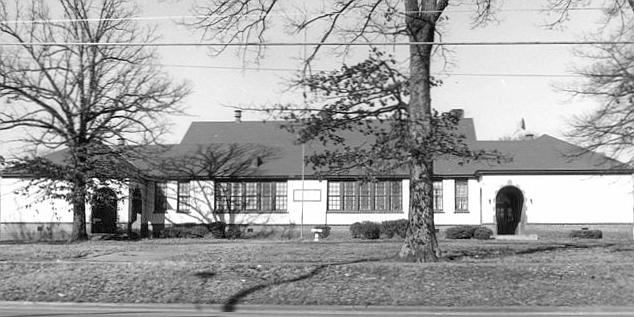

Rison School: Built by the Dallas Manufacturing Company, a cotton mill, Rison School opened its doors in 1921. The school was built to educate the children of the cotton mill workers. Rison School was named for mill general manager Archie L. Rison. Collins Wynn has compiled a very interesting article on the history of the Rison family in Madison county. It is available in PDF format by clicking here. A photograph of the old Rison Family Home is shown below: Photo Courtesy of Huntsville Public Library 314 W. Holmes Avenue Huntsville, Alabama (demolished in 1967)
(Click here for a brief history of Bradley, Rison, and Lee High Schools by Cecil V. Fain) Education in the Dallas Village area was first offered in a residence on O'Shaughnessy Avenue and in the Moore residence behind the Rison School building. The school grew from an elementary school to include junior high and then to also include senior high. Hundreds of boys and girls graduated from the senior high school and have gone out in life to become outstanding citizens. However, operating twelve grades on a "shoestring" and an ever-increasing attendance caused the need to release the three senior high grades to the Butler Consolidated School. Rison School then became an elementary and middle school with grades 1 through 9. In 1967, the students in these classes were dispersed to three different schools, Chapman, Lincoln and Colonial Hills, depending upon the area in which they lived. Memory fails us as to the activities at Rison School during the interim between 1967 and the mid-70s. If you remember, please let us know. Note: Jon Edmonds wrote us and said, "I believe for a time Rison was used as a HALMA (Huntsville Art League) facility - that may be part of the missing history." So, that could account for all or a portion of that time period; thanks Jon. (Please see Jon's complete message at the "Notes from Friends" page.) Note: In April, 2010, Jim Zielinski wrote to say: "When the old West Clinton School was slated for demolition, The Arts Council, Inc. (TAC) and a number of its member organizations were compelled to look for a new—albeit temporary—home. They found it at the old Rison School, moving in during August 1973. During this period, performances for the groups were typically held at Lee High School, Huntsville High School, the Russell Erskine Hotel, and various churches. As it aged, Rison was deemed both uninhabitable and too costly to renovate. The arts were on the move again; in 1975 TAC relocated to a suite of offices in the new Von Braun Civic Center where it remains to this day, while four member organizations temporarily relocated to Annie C. Merts Center on Randolph Avenue. Thanks Jim. (Please see Jim's complete message at the "Notes from Friends" page.) In the mid-70s the Rison School building then became a facility for the Daycare Association of Huntsville and Madison County, a United Way Agency. Community Ballet classes were also conducted there. Alas, our dear old Rison School was torn down in the early 90s to make way for progress. An elevated portion of Highway I-565 was constructed over the site where the school once sat. An area City Fire Station was built on a portion of the school site. Mr. Fain once stated that it was politics that caused the demise of Rison School, and that the path for I-565 could have taken a different route thus saving our beloved school. The following pictures were made before they tore the school down to make way for the fire station.
 Please notice the railings to the right beside which there were steps leading to the basement that housed the school's furnace. The basement was also the janitors' "office!"
(Picture furnished by Cecilia [SIS] Watson) If you look at the picture of Rison School, it's as if you can see that it's dying - deserted and lifeless. Notice too in the above picture that the Rison plaque is gone (it’s on display on the grounds at the Coca-Cola plant on Meridian Street), water fountains are down, the window coverings are either askew or missing (it appears that some of the windows may be missing), some trees are missing, the dome is missing from the roof, and the flagpole is gone. To the left in front of the school, there appears to be a waste bin awaiting the school's debris - a sad picture. Oh that the Association had been prepared at that time to receive and store the artifacts from the school. But, the fact is, we weren’t and it’s easy to understand - we had neither the funds nor the facility in, or on, which to place the artifacts. We are indebted to Bobby Wilkinson of the Coca-Cola Company for obtaining and preserving, in a 24 hour secure and well kept location, some of the key artifacts from the school. Except for a business interest that his company has with Huntsville, Bobby had no tie with Rison other than his wife, Elizabeth, was a graduate of the school. We sincerely thank you Bobby for doing for us at that time what we weren’t prepared or able to do for ourselves. Editor's Update, July 26, 2005: We've learned from Bobby Wilkinson that he did have a tie with Rison as well as to Dallas Mill and to the village. Bobby's father, John Lee, attended Rison School. Bobby's grandfather, Lee Wilkinson, was a supervisor at Dallas Mill. Our friend, Sara Ann Certain Hymer, remembered when Mr. Lee Wilkinson lived at #1 North Dallas (now Lee High Drive) and Sara Ann lived at #13 North Dallas. When a little girl, Sara Ann said that the senior Mr. Wilkinson gave her a gold coin that she treasured. She now feels that he probably gave her the coin because of the close relationship that his son, John Lee, had with her father, Lionel Certain. Sadly, the coin has been missing for several years and Sara Ann has no hope of finding it. So, while we could dwell on those things that we lost, we prefer to concentrate instead on those things that we found - and kept – like pride, determination, and a sense of belonging. As has been said, in part, we are who we are by the experiences we had at Rison School.
 First row, seated, left to right:?? Second row, left to right: ?? Third row, left to right: Mrs. W. P. Nicholson (Teacher), ??, ??, ??, ??, ??, Clarice Certain, ??, ?? Fourth row, left to right:?? Fifth row, left to right:??, ??, ??, Gordon L. Starr, ??, ??, ??, ??, ??, ?? Do you know the missing names?  Front row, seated, left to right: ??, Elizabeth Fanning, ??, ??, ??, ??, ??, ?? Second row, seated, left to right: Elizabeth Primm, ??, Kittie Primm, ??, ??, ??, ?? Third row, left to right: ??, ??, ??, Joy Fanning, ??, ??, ?? Fourth row, left to right: ??, Ewell Starr, ??, ??, Wilbia Lee Starr, Clara Mae Brazelton, ??, ??, ?? Fifth row, left to right: ??, ??, ??, ??, ??, ??, Leonard Williams, ??, ??, J.D. Primm Do you know the missing names?  Center, front: Bob Englebert Left of center, front to back: Rice Schrimsher, Icie Renegar, J.D. Primm, Mary Ealy, Kitty Primm, Mildred Routt, Ester Tolen, Mildred Routt, Rex Carter, Margaret Wakefield, Wilbia Lee Starr, Charlie Steger, Mary Worley, Earlene Reese Right of center, front to back: Dorothy Cope, Vernon Davenport, ??, Walter Cullom, Katie Sue Cobb, Clezelle Schrimsher, Lillie Ella Fitch, Rellalee Wharton, Joy Fanning, Mertice Steger Back row, right to left: ??, Ozella Curry, Earlene Reese, J.J. Berryhill Sign holders, left to right: Shirley Steger, Hubert Widner, Roy Hale, Perry Chisam
 Front row, left to right: Jack Hucks, (?)Anderson, Mrs. Carpenter, Bud Adcock, ??, ?? Second row, left to right: Mona King, Ophelia Millsap, Betty Schrimsher, Lillian McGehee, Elizabeth Eaton, Norma Headrick, ??, Myrtic Locke Third row, left to right: Mrs. Dubose, Bertha Payne, ??, Edsel Webb, Ruby McKinney, Albert McDonald Fourth row, left to right: Ray Vandiver, ??, ??, Bobby Hughes, ??, ?? Back row, left to right: Jimmy Monroe, Nancy Brown, *Vernon Ivy, ??, ??, ?? Do you know the missing names? *Son of P.R. Ivy, the first principal of Rison School.
 This is the only known photo of Coach Myhand in the classroom and was taken in the final few years of his teaching and coaching career.
Considering the rows to run from the front of the classroom to the rear and starting with the row nearest the camera as Row 1 and ending with Row 5 as the one farthest away, the names are: 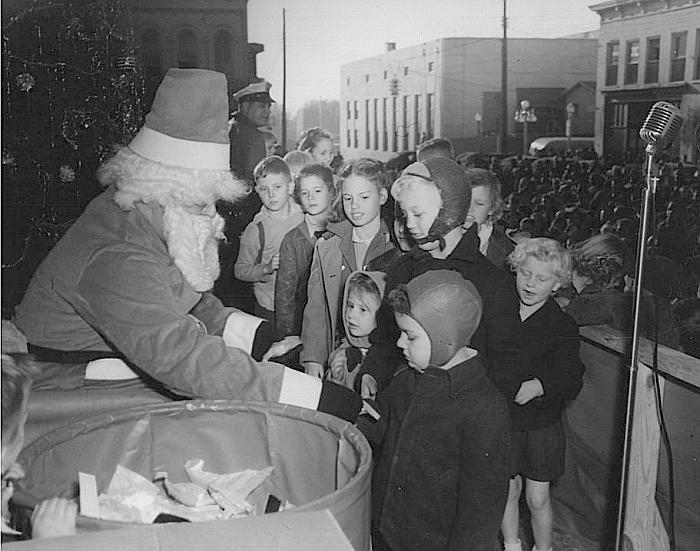 Bill said: "I don't remember much about that day except that it was cold and there was a parade. Santa was set up on the square across the street from the old Montgomery Ward store. We were really surprised when the picture turned up on the front page of the newspaper!"
 1st row, left to right: Tony Campbell (4th boy from right) 2nd row, left to right: 3rd row, left to right: Miss Esslinger, teacher Do you know the missing names?
Editor's note: If you either know of other grocery stores or know the missing name, please send an email to risondallas@bellsouth.net and the list will be updated. Sometime in the future, one of our friends will create a map of these stores.
From Old Huntsville Trivia in the Old Huntsville Magazine: Used by permission.
1891 - The announcement that Dallas Cotton mills will be located in Huntsville is greeted with wide-spread jubilation. Huntsville has a population of 1,327 citizens. Also seen in the Papers in 1891 (Used by permission from Old Huntsville Magazine)

The information provided about Dallas Mill is shown below:
Here is a drawing of Cambron Covered Bridge on Green Mountain by Jerry Brewer 
A Poker Game, Circa 1920  Editor's note: When growing up in Dallas Village, many children, both girls and boys, learned to play poker at an early age, not necessarily to gamble, but for the fun of it and perhaps because cards were cheap and available. Kids of today have so many other games and distractions that playing poker is probably not as appealing. However, with the popularity of poker games now on TV, kids may have become more interested. This picture also makes one think that the players were very brave to be photographed in a gambling set with what appears to be alcoholic beverages, but gambling and drinking may not have been unlawful in the state of Tennessee at that time. Please note the man with the "Charlie Chaplin-type" hat. Speaking of gambling, Dallas Village had a few well-known gamblers, with Charles Esslinger probably being the most famous. Please click here to read a story (courtesy of the Old Huntsville Magazine), titled, "The Gambler" The Dallas Mill site is apparently haunted, as described in this article in Old Tennessee Valley Magazine. It tells of a mill worker who met a fiery death in one of the mill's massive coal burners and who perhaps continues to walk the empty field, looking to finish the job that cost him his life that day so long ago. There is also a rumor of the ghost of a homeless man who wanders the site. Have you ever heard these stories? Have you seen either the ghost of the mill worker or the homeless wanderer? If so, send us a message using the email link at the bottom of this page. Collins Wynn has discovered some interesting information on an old Dallas Mill neighborhood cemetery. Click here to read this interesting article. CEMETERY UPDATE, JUNE 16, 2006: Here's the cemetery marker that has been added to the Dallas Mill cemetery. Over time, additional upgrades will also be made to the cemetery. We're grateful to our councilman, Mark Russell, who made the marker and upgrades happen.
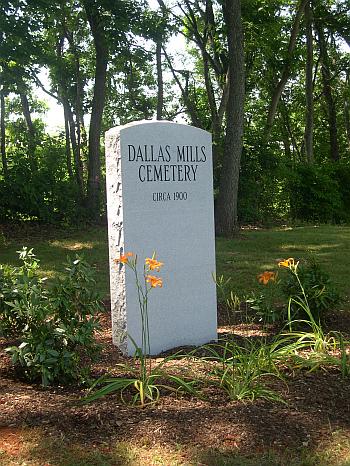
Here is another interesting article from a 1905 Huntsville newspaper concerning a fire in Dallas Village:
And here is a similar story:
And Another Story:
And here is a humorous article from a 1907 Huntsville Newspaper concerning a new cow law (although at the time I'm sure this was serious business indeed):
The History of Mullins Restaurant Most of us don't remember when there wasn't a Mullins. There were three different locations, under different names, all of which were within a couple blocks of each other. The menu for the present Mullins Restaurant gives Mullins' history as follows:
In April, 1929, just prior to the Great Depression, the Mullins family opened the Fifth Street Cafe. In 1949, the restaurant moved to a new location under the name Mullins Drive-ln. Then in 1978, Larry and Brenda Mullins purchased the restaurant from his father, James P. Mullins. Larry can remember selling hamburgers twelve for a dollar and breakfast for thirty-five cents. In 1966, the restaurant moved to its present location and has become the largest independent buyer of food in the northern part of Alabama. The addition includes a 2,100 square foot kitchen with a cooler and freezer unit that can hold four trailer loads of food. Mullins Restaurant donates two college or university scholarships a year, in the names of Larry and Brenda's parents, to local high school students. To enjoy a tasty and charming part of Alabama's oldest family-owned restaurants, visit Mullins Restaurant and take the time to view the pictures on the walls to see the changes that have been made in Huntsville since the 1920s.
Here is a photograph of the memorial plaque dedicated to Hub Myhand that was installed at the Optimist Park in December of 2009.  An interesting story about a "treasure hunt" at Optimist Park can be found at the Have Detector, Will Travel website by J.R. Hoff. The text of that article is reprinted here if you have trouble with the other link.
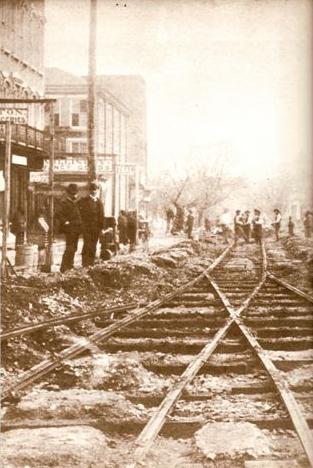 Photo courtesy Huntsville A Pictorial History, by Dave and Sharon Dooling We are unable to determine the exact location of this picture in downtown Huntsville.
"There was a streetcar track right down the middle of Stevens Ave. to a point two blocks west of Fifth St. At this point the street car motorman would reverse the trolley pole and run the car back east on Stevens to a point one block east of Fifth St. where the track turned south toward downtown Huntsville to a point now known as Five Points then turning right for one block then turning slightly to the left down East Holmes St. to Washington St. where it turned left at the store known now as Belk Hudson. This is the most definitive information that we have about the streetcar route. Our friend, Glenn Hymer, remembers that his uncle, Leonard (Pont) Pinion, said that there was a wide place on Holmes Avenue where there was a side track. There were two streetcars and it was at this place where they passed each other. The first one there pulled over on the side track, waited for the other one to pass, and then returned to the main track where both continued on their journey. As a boy, Pont also remembered jumping on the back of the streetcar and riding from Dallas Village to West Huntsville without paying a fare. Editor's update 04/21/06: According to an employee of the Huntsville Engineering Office, the side track was located at the intersection of East Holmes and White Street, about where the Tenders Restaurant is now located. A visit to the site revealed no evidence of the track's existence. When asked, the employee stated that the track is probably underneath the paving.
 Photo courtesy Huntsville Alabama Sesquicentennial 1805-1955
This picture is assumed to be the first streetcar in Huntsville, presumably circa 1900 rather than circa 1920 as previously thought. Editor's note: If the streetcar ran on Oakwood Avenue it could well be that the streetcar is in front of the bosses row of houses on the north side of Oakwood Avenue between N. Dallas Avenue and the RR tracks. For a period of time, Mr. and Mrs. Fain lived in the house at the corner of Oakwood and N. Dallas; my paternal grandparents lived in the second house from the RR and these houses looked much like the picture. I don't remember the cobblestone street though, but then it's unknown what year the streetcar ended and the cobblestone streets were either removed or covered. Maybe most of us hadn't yet been born! As one analyzes the picture, you see that the seats were probably very uncomfortable. While the conductor's seat has a back pad, the other seats may or may not have them, but there's no pad on the seat bottom. Although there seems to be curtains that could be lowered, imagine how cold it would be in the wintertime and miserable it could be in a downpour or a blowing rain. Maybe the streetcar just didn't run in extreme weather. But, all in all, it was probably exciting to those using it. I also wonder if the picture was staged or if it represents the passengers at that particular time; it appears that there could be one female passenger. 'Wonder how the passenger alerted the conductor when the streetcar reached his/her stop. There may have been regular stops from which a passenger would select, something like the bus system was when I was a young girl. The bus didn't stop at McKinley Avenue on which I lived, so I had a choice of getting off at either the corner of Oakwood and Fifth Street or at the corner of Halsey Avenue and Fifth Street. Please notice the ads.

Mayor Tom Smith, the Board of Aldermen, and D.C. Monroe's band are aboard the third streetcar, upon dedication of the Huntsville Railway Company system in February 1901. Joy Fanning Daniel said that she rode the latter style streetcar many times and just loved it.

(Contributed by Judith Gunn Crawford) 
 Front, seated on step: Marguerite Gunn holding Raymond Falkenberry Second row, left to right: John Gunn, Jr., Frank Falkenberry, Jr. Third row, left to right: Carrie Gunn, Bettie Gunn Falkenberry, Lillian Gunn, Ida Gunn, Florence Hutto, holding son, Ernest Hutto, Lorena Gunn Fourth row, left to right: Frank Falkenberry, Raymond Gunn, John Elery Gunn, Grady Hutto
| |||||||||||||||||||||||||||||||||||||||||||||
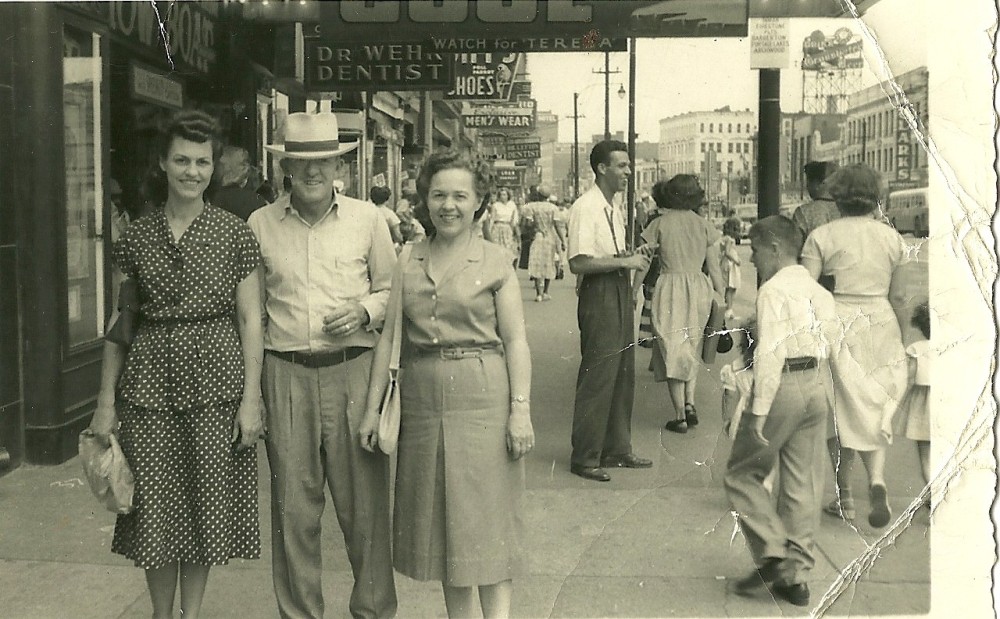
You may proceed to Page 3 of our Rison-Dallas History by clicking here.